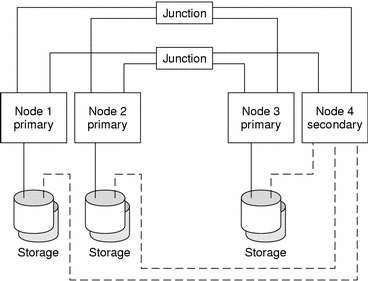Sun Cluster Topologies
A topology is the connection scheme that connects the cluster nodes to the storage platforms used in the cluster.
Sun Cluster supports the following topologies:
-
Clustered pairs
-
N+1 (star)
The following sections describe each topology.
Clustered Pairs Topology
A clustered pairs topology is two or more pairs of nodes operating under a single cluster administrative framework. In this configuration, failover occurs only between a pair. However, all nodes are connected by the private networks and operate under Sun Cluster software control. You might use this topology to run a parallel database application on one pair and a highly available application on another pair. Using the cluster file system, you could also have a two-pair configuration where more than two nodes run a scalable service or parallel database even though all of the nodes are not directly connected to the disks that store the application data.
The following figure illustrates a clustered pair configuration.
Figure 2-3 Clustered Pairs Topology

Pair+M Topology
The pair+M topology includes a pair of nodes directly connected to shared storage and an additional set of nodes that use the cluster interconnect to access shared storage--they have no direct connection themselves. All nodes in this configuration are still configured with volume managers.
The following figure illustrates a pair+M topology where two of the four nodes (Node 3 and Node 4) use the cluster interconnect to access the storage. This configuration can be expanded to include additional nodes that do not have direct access to the shared storage.
Figure 2-4 Pair+M Topology

N+1 (Star) Topology
An N+1 topology includes some number of primary nodes and one secondary node. You do not have to configure the primary nodes and secondary node identically. The primary nodes actively provide application services. The secondary node need not be idle while waiting for a primary to fail.
The secondary node is the only node in the configuration that is physically connected to all the multihost storage.
If a failure occurs on a primary, Sun Cluster fails over the resources to the secondary, where the resources function until they are switched back (either automatically or manually) to the primary.
The secondary must always have enough excess CPU capacity to handle the load if one of the primaries fails.
The following figure illustrates an N+1 configuration.
Figure 2-5 N+1 Topology

- © 2010, Oracle Corporation and/or its affiliates
